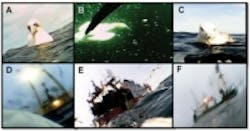Miniature cameras provide birds' eye view of UK's largest seabird
By attaching lightweight, miniature cameras and GPS devices to 20 gannets, scientists from the University of Exeter and the Royal Society for the Protection of Birds (RSPB) have captured footage and flight paths of the UK’s largest seabird.
Dr. Stephen Votier from the University of Exeter’s Environment and Sustainability Institute and Dr Mark Bolton from the RSPB, have been conducting research on the gannets on the island of Grasshold off the Pembrokeshire coast for the past eight years. Grasshold is home to the fourth largest gannet colony in the world, with just under 40,000 breeding pairs. As a result, the team attached 45g specially-designed digital cameras from Perthold Engineering with fish-eye lenses, along with iGotU GT-600 GPS loggers in order to study the birds’ habits.
"The lightweight camera works alongside a GPS unit that allows us to accurately track birds’ flight patterns and measure how long they are flying, feeding or resting," said Bolton. "This information can answer both scientific and conservation questions and could contribute to the designation of marine conservation zones in Wales."
In addition to answering questions about conservation benefits, the researchers hope this data will enable them to safeguard the seabirds at their breeding sites through a network of nature reserves and Special Protected Areas, but at present, little protection exists in the birds’ present environment, according to the RSPB.
Ultimately, the goal of the project is to plan a long-term strategy for safety and conservation of the birds, according to Votier.
"Gannets are long lived seabirds and there is still much to learn about their life away from the breeding colony," he said. "The application of technology to study the private lives of gannets has been influential to our research in the short-term, but the goal is to continue this work in the long-term to help provide a sustainable future for gannets and other marine life."
Following the completion of the video portion of the research project, the team was able to remove and retrieve the cameras from the gannets used in the study.
View the PLOS ONE research paper.
View a press release from the University of Exeter.
Also check out:
UAVs create 3D model of the Matterhorn
Satellite smart cameras help combat poaching of endangered species
Image processing software identifies animal gender and age from footprint
Share your vision-related news by contacting James Carroll, Senior Web Editor, Vision Systems Design
To receive news like this in your inbox, click here.
Join our LinkedIn group | Like us on Facebook | Follow us on Twitter | Check us out on Google +
About the Author

James Carroll
Former VSD Editor James Carroll joined the team 2013. Carroll covered machine vision and imaging from numerous angles, including application stories, industry news, market updates, and new products. In addition to writing and editing articles, Carroll managed the Innovators Awards program and webcasts.
